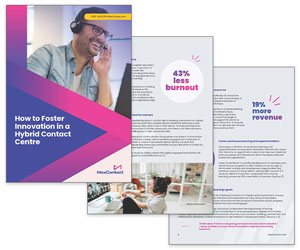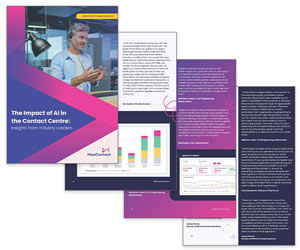In the era of The Great Resignation, staff wellbeing and engagement is certainly a hot topic right now.
Many employees are leaving due to feeling burnt out, unsupported, or undervalued in their roles. In fact, our research shows that 72% of workers said they were burnt out, and 52% said there had been an increase in workload since the beginning of the pandemic.
In the contact centre world, 64% of people reported that they were losing between three to four hours of work each month due to poor work-related mental wellbeing.
And this could have a huge effect on the wider business!
To talk about how leaders can improve wellbeing and company culture, we invited Natalie Calvert, CX+EX Coach & Expert, and Sean McIver, Product Owner at MaxContact, to a recent webinar.
You can watch the webinar in full or keep reading for the key takeaways.
Why Leaders Should Prioritise Employee Wellness
On a human level, prioritising wellness and checking in with employees is always a sign of good leadership. But the benefits go beyond that.
Research shows that good company culture increases customer experience by upwards of 75%. So it’s no wonder that 70% of executives say it’s their number one priority.
There’s a clear key link between company culture and employee wellbeing, customer satisfaction, and business performance.
But improving culture and wellbeing is not a quick and easy fix.
The customer contact industry has always had a high staff turnover, but this has increased significantly during the pandemic and The Great Resignation.
Studies show that employees are feeling burnt out and stressed which is causing them to leave en masse.
Increased employee turnover can hurt businesses in many ways, including the bottom line. On average, it costs between £3,000 to £5,000 to recruit new staff and around 20,000 hours of training to get them up to speed.
It’s no surprise that leaders want to avoid a revolving door of staff, so they can spend that time and money on growing the business. But for this to happen, the company needs to prioritise employee wellbeing and culture.
How to Reduce Stress for Contact Centre Workers
Any job surrounding customer care, queries, or complaints can come with some stress attached.
Angry customers are feeling the strain of a cost-of-living crisis, life post-pandemic, and the challenges of an increasingly remote world thrown into the mix.
But what can leaders do to protect their contact centre workers? As Natalie explained, we’re creating some of our own stress in a way.
A few years back, workers needed an entirely different skill set than they need today. The world has changed so much, so fast, and contact centre workers have to deal with increasingly complex issues, more demanding customers, and a whole range of other issues that many workplaces aren’t prepared for.
She believes that we really need to reskill our people, leaders especially, to match the needs and expectations of the modern world. If we don’t ensure our frontline staff have the right skills, we can expect high burnout and low staff retention rates.
Another thing that Sean suggested was having a system where customer complaints are recognised and analysed for trends. If frontline staff know there’s a common issue that’s being addressed at a higher level, this provides a bit more backup and support for team members dealing with angry customers.
Ultimately, leaders need to really understand the value of their people and do whatever they can to manage, coach, and support them through stressful times.
Balancing Business Growth With Staff Needs
Of course, all businesses want to grow, and growth can sometimes be uncomfortable.
But rather than focusing entirely on hitting quotas, business objectives, and handling increased pressure from customers, leaders should try to address company culture across the board.
This is not just something that affects frontline staff either. There needs to be a culture across all areas and roles, such as QA managers, finance, suppliers, and leadership.
Every subsection of the business should feel valued and supported. And sometimes, all it takes is a quick check-in with staff and some open and honest conversations.
As a business prepares to grow, so with it must the plan to support staff. Increasing or decreasing team sizes, revamping company structure, and training must all be done with employee wellbeing in mind.
“Great employee engagement is designed. It doesn’t just happen naturally” – Natalie Calvert, CX+EX Coach & Expert
How to Manage Staff Wellbeing in a Remote Setting
Natalie has two tips for this:
- Keep cameras on
- Run team huddles
Keeping cameras on during meetings is critical because you can actually check in with people and see how they’re doing. If your team has cameras off, there’s little engagement, and it’s harder to pick up on things that could affect staff wellbeing.
Natalie is also a fan of team huddles, which are short and sweet meetings where everyone can gather for a chat. While they take time to run, Natalie says they are well worth the investment because of the impact on employee engagement and wellbeing.
Why Businesses Should Care About Employee Engagement
One of the top reasons is that it affects recruitment and retention. Engaged employees are simply less likely to quit.
When you have a group of engaged employees, you’re ensuring that they feel valued and listened to. You are also demonstrating that you are prepared to adapt and adjust as necessary.
On a wider scale, having engaged staff means better performance when it comes to business aims and objectives. Highly engaged employees are much more likely to deliver great customer experience, which impacts customer satisfaction and, ultimately, revenue. So, it’s a win-win.
But Natalie has a word of advice. Good employee engagement won’t happen spontaneously. You have to design it and to do that, you need great leaders who are committed.
Maximising Employee Engagement in a Remote World
Just like with wellbeing, managing engagement can be extra tough when everyone’s working remotely.
But Natalie suggests focusing on a few key areas that impact employee engagement:
- Customers – Be customer-focused in all areas of the business – not just in customer interactions, but also in internal communications in the team.
- Purpose – The purpose of the contact centre has to align with the purpose of the overall organisation.
- Culture and Community – Build a great culture focused on your community.
- Improvement – Make constant improvement a primary goal across each area of the business.
- Structured Development – Focus on staff development and skills.
- Rewards and Recognition – Celebrate successes and reward staff so they know they’re valued.
“The more engaged a member of the team is, the more likely they are to feel valued at an individual level. And that’s hugely important.” – Sean McIver, Product Owner, MaxContact
Five Ways to Improve Employee Engagement and Wellbeing
Ready to rethink employee engagement and wellbeing but don’t know where to start? Natalie and Sean have you covered. Here are their top five methods for improving wellbeing and engagement:
1. Have a Strategy and a Plan
If you don’t have a plan to improve things, you can’t expect them to improve by themselves. Go in with a plan of action.
2. Talk Openly and Honestly
Sean’s tip is to be proactive, not passive, when it comes to open communication. It’s hard to know if there are any issues with staff wellbeing if no one’s talking about them. Encourage leaders to be proactive about communicating with their teams.
3. Make Sure Leaders Have the Right Skills
It all starts with leadership, as Natalie says. They need the right skills to coach and support the rest of the business. When good leadership is in place, this trickles down to employees and customers as well.
4. Culture
Customer service and customer experience teams shouldn’t work in silos. Everyone needs to be on the same page when it comes to company culture, feeling valued, and knowing the core purpose of their roles.
5. Employee Engagement Goes Hand in Hand With Customer Experience
These are not two separate things. They are intrinsically linked. If employees feel valued and engaged, this will result in better customer service and happier customers.
So, if you want to improve the customer experience, one step is to tackle any employee wellness issues you have in your team.
This blog post has been re-published by kind permission of MaxContact – View the Original Article
For more information about MaxContact - visit the MaxContact Website
Call Centre Helper is not responsible for the content of these guest blog posts. The opinions expressed in this article are those of the author, and do not necessarily reflect those of Call Centre Helper.
Author: MaxContact
Published On: 17th Nov 2022 - Last modified: 16th May 2024
Read more about - Guest Blogs, MaxContact, Natalie Calvert






 MaxContact is customer engagement software that goes above and beyond to build smarter customer experiences. Our platform is packed with powerful features, accessible for businesses large and small, and ensures organisations can operate compliantly.
MaxContact is customer engagement software that goes above and beyond to build smarter customer experiences. Our platform is packed with powerful features, accessible for businesses large and small, and ensures organisations can operate compliantly. 































